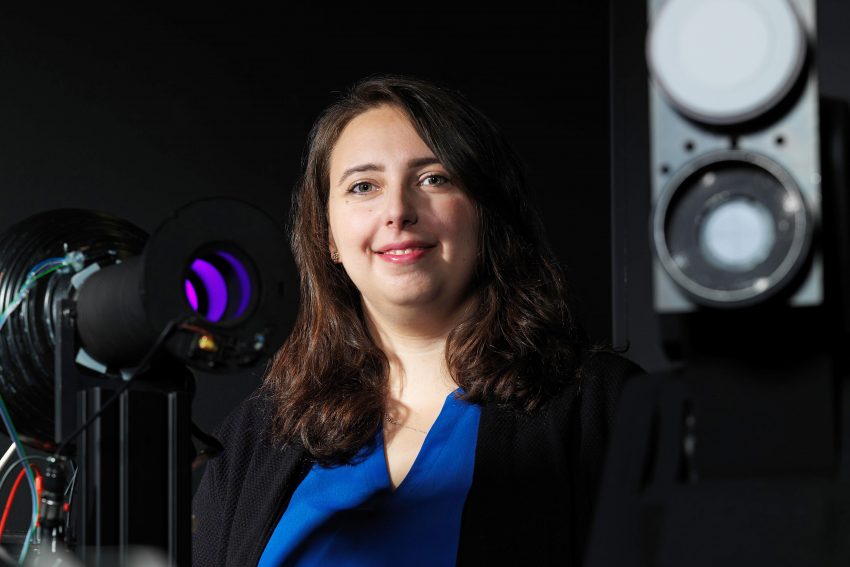Standard White From Ultraviolet to Infrared Irina Santourian from the Graduate School B-IGSM in portrait
In the “Braunschweig International Graduate School of Metrology” (B-IGSM), about 50 doctoral students are dedicated to the science of precise measurement. They are all supervised both at Technische Universität Braunschweig and the Physikalisch-Technische Bundesanstalt (PTB). At PTB, Irina Santourian conducts research at the gonioreflectometer, a measuring station that measures light reflections. In an interview, the doctoral student explains how she would like to improve the German standard for white and gray shades.

Irina Santourian next tot the gonioreflectometer. Picture credits: PTB
Who are you and what is your research topic?
My name is Irina Santourian and I am researching an alternative radiation source for the gonioreflectometer at PTB. Thus, I am part of the Department of Applied Radiometry of Germany’s national metrology institute. There we measure the reflection of optical radiation in the visible range as well as in ultraviolet (UV) and infrared (IR). Above all, we calibrate white standards, which are passed on as reference to a large number of customers from industry and research.
Which research question are you working on?
The gonioreflectometer has three main components: A turntable with a light source, inside the sample on a robot arm and outside the turntable the sensors that do the actual measuring work. We measure the radiance factor. This describes how strongly a diffusely reflecting surface reflects optical radiation, depending on the direction of incidence and exit and the color of the sample. The reference value is always the so-called perfectly reflecting sample, the whitest white, so to speak. The gonioreflectometer can determine the reflectance value of samples for all directions of incidence and reflection angles and for any wavelength. The built-in 400-watt halogen lamp is well suited for visible light and infrared radiation. In the UV range, however, there is still room for improvement. I am investigating to what extent UV LEDs as an alternative radiation source can improve the device. The stronger UV radiation could not only save measuring time, but also provide more precise results for the radiance factor.
What inspires you about your research?
I’m excited about being able to increase the precision of already highly accurate procedures and equipment even further. Of course, this is associated with constant challenges. This starts with the selection of the LEDs. After all, the LEDs I use now must still be available in years to come. Otherwise everything would have to be recharacterized. In my work area, I can see right away that the effort is worth it. For example, when my work is used for other research tasks or customer orders.
How is your topic relevant to metrology?
How white something is, even in the infrared and ultraviolet range, can be determined on the basis of reflection – for example with the radiance factor mentioned above. PTB’s gonioreflectometer is the national standard for directed reflection measurements. Here we calibrate the white standards, which are precisely measured and passed on to customers as a reference.
Not only scientists need this certainty. Because without this traceability through the white standard, paper and white materials are no longer consistently white. It cannot be assessed how white a detergent washes. Reflectance and color fidelity are indispensable in car paints, cosmetics and architecture. Our services are in corresponding demand. The gonioreflectometer runs almost 24 hours a day, seven days a week. It only stands still while we change the sample. If I can further accelerate and refine the process with my work, we’d better cover the need for calibrations.
What is so special about participating in the B-IGSM research training group?
What is special for me is the active exchange with other doctoral students in the field of metrology. Thanks to the cooperation between PTB and TU Braunschweig, I am constantly gaining new insights from the most diverse disciplines. This gives me fresh food for thought and in turn improves my own work. Since the research training group is very internationally oriented, you can also develop yourself individually and learn a lot of new things. Before the Corona-related lockdown, the exchange was even more personal, but even now us doctoral students stick together and we make the best possible use of the difficult situation. I am happy to be a part of this network.
